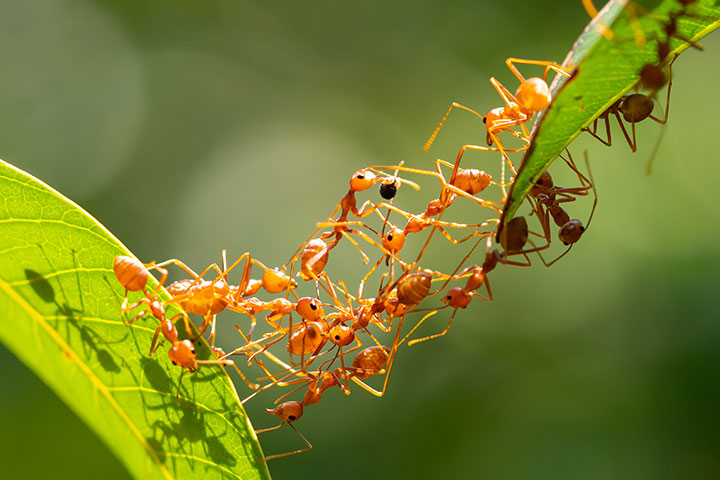The Extraordinary Language of Ants: Decoding the Intricacies of Ant Communication

Introduction:
In the intricate world of insects, ants stand out as remarkable communicators, relying on a sophisticated system of signals and chemical cues to coordinate their complex societies. The realm of ant communication is a fascinating tapestry of chemical trails, tactile interactions, and intricate dances, revealing a level of organization and cooperation that has captivated scientists and enthusiasts alike. This extensive exploration delves into the extraordinary language of ants, unraveling the mysteries of how these tiny creatures effectively convey information, make decisions, and build thriving colonies.
Chapter 1: The Social Fabric of Ant Colonies
Before delving into the nuances of ant communication, it’s crucial to understand the social structure of ant colonies. Ants, as eusocial insects, live in highly organized communities where individuals assume specific roles. From queens and workers to soldiers and foragers, each caste plays a vital part in the collective success of the colony. The interconnectedness of these roles forms the foundation for the intricate communication network within the ant world.
Chapter 2: Chemical Conversations: Pheromones and Trail Following
At the heart of ant communication lies the use of chemical signals, specifically pheromones. Ants release pheromones to convey a myriad of messages, from marking trails to signaling danger or indicating the presence of food. The ability to follow pheromone trails allows ants to navigate their surroundings efficiently. This chapter explores the chemical conversations that shape the behavior and coordination of ant colonies.
Chapter 3: Tactile Talks: Antennae and Trophallaxis
In addition to chemical cues, ants engage in tactile communication, primarily through the use of their antennae. Antennae serve as sensitive organs that detect various signals, allowing ants to communicate through touch. Trophallaxis, the sharing of food mouth-to-mouth, is a notable example of tactile communication, fostering social bonds and the distribution of essential nutrients within the colony.
Chapter 4: Waggle Dances and Orientation: Mapping the Environment
Certain ant species, like the famous honey ants, utilize intricate dances to communicate information about food sources and nest locations. The waggle dance, characterized by specific movements and patterns, serves as a navigational guide for other colony members. This chapter explores how ants employ dance as a sophisticated means of orientation and sharing crucial spatial information.
Chapter 5: Alarm Signals and Collective Defense
Ant colonies face constant threats, ranging from predators to rival ant colonies. To address these challenges, ants have evolved elaborate alarm signals that trigger rapid and coordinated responses. The release of specific pheromones alerts colony members to potential danger, prompting them to adopt defensive postures or initiate collective actions to safeguard the nest.
Chapter 6: Evolutionary Insights: Adaptations in Ant Communication
Ant communication is not static; it evolves in response to environmental changes and challenges. This chapter delves into the evolutionary aspects of ant communication, examining how different ant species have developed unique signals and strategies based on their ecological niches, social structures, and survival imperatives.
Chapter 7: Studying Ant Communication: Insights from Research
Scientific inquiry has played a pivotal role in unraveling the complexities of ant communication. This chapter explores landmark studies and experiments that have contributed to our understanding of how ants communicate. From laboratory observations to field studies, researchers employ diverse methods to decode the language of ants, providing valuable insights into their behavioral patterns and cognitive abilities.
Chapter 8: Mimicry and Deception: Intricacies of Ant Communication Strategies
Ants face not only internal communication challenges but also external threats, including predators and parasitic species. Some ants employ mimicry and deception as strategic tools to manipulate the communication systems of other ant colonies or exploit the resources of rival nests. This chapter uncovers the intriguing world of deceptive strategies within ant communication.
Chapter 9: Technological Advancements: Ant-Inspired Robotics and Communication Systems
Inspired by the efficiency and adaptability of ant communication, scientists have explored applications in technology. This chapter delves into the intersection of biology and robotics, showcasing how ant-inspired communication systems have influenced the development of swarm robotics and decentralized communication networks.
Chapter 10: The Ongoing Saga of Ant Communication: Unanswered Questions and Future Directions
Despite significant strides in understanding ant communication, numerous mysteries persist. This final chapter examines the unanswered questions and outlines the potential avenues for future research. As scientists continue to unveil the secrets of ant communication, the ongoing saga promises to reveal new insights into the intricacies of insect societies and the principles that govern their collective behavior.
Conclusion: Deciphering the Ant Code
In conclusion, the language of ants is a mesmerizing code woven into the fabric of their societies. Through chemical signals, tactile interactions, dances, and complex behaviors, ants communicate with a precision that reflects the efficiency of their colonies. Deciphering the ant code not only unveils the remarkable adaptations of these tiny creatures but also provides a window into the fundamental principles of cooperation, organization, and survival that transcend the scale of their miniature world. As we continue to decode the language of ants, we gain not only a deeper understanding of insect communication but also valuable insights into the intricate tapestry of life on Earth.




